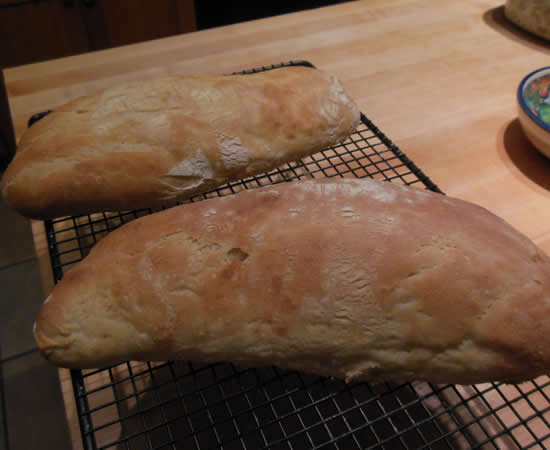Tonight’s dinner was brought to you by a magazine ad for an Italian Soup. I looked at it and realized I had a chicken, a package of tortellini, and a better grasp of Italian cooking than the folks who came up with the ad.
I follow guidelines for certain soups, as when I make Mulligatawny, but really… soup is throwing stuff in a pot. It ain’t brain surgery and it ain’t difficult.
Canned and packaged soups rely on chemicals and flavor-enhancers for taste. Unfortunately, a lot of people only relate to the trickery that food manufacturers use in their products and feel underwhelmed when they make things at home – not understanding that real food without additives tastes different – and better. It becomes a retraining of the taste buds to learn how good individual foods taste and how well different foods blend together.
That being said, soup is still throwing stuff into a pot. As much or as little as you like.
Bread – and baking – takes a bit more science.
I’ve actually never made a ciabatta bread before and was glad my first attempt was from a trusted source. I used a recipe from The Italian Baker by Carol Field. The dough is quite unlike most bread doughs and she stresses several times not to succumb and add more flour than called for. It was good advice that I’m sure I would not have followed from other cook books. But I’ve been baking breads from her book for years and know when to pay attention.
The dough is quite wet and sticky so it does not translate to making by hand. Use a mixer. And really resist adding more flour. Really.
The biga needs to set out for 12 hours, so start the day before you want the bread.
Ciabatta Bread
for biga:
- 1/8 tsp active dry yeast
- 1 cup water at room temp
- 1 1/4 cup all purpose flour
Dissolve yeast in water, add the flour and form a sticky dough. Leave it covered at room temperature for 16 to 24 hours.
for the final dough:
- 3 tbsp warm milk
- 1 tsp active dry yeast
- 2/3 cup water
- 1 tbsp olive oil
- 1 cup biga
- 2 cups all-purpose flour
- 1/2 tbsp salt
Using a mixer, stir the yeast in the milk and let it stand for a couple of minutes in the bowl. Add the water, oil, the biga, and mix to incorporate, dissolving the biga in the liquid. Add the flour and salt, and mix at low speed for a couple of minutes. Change to the dough hook and knead 2 minutes at low speed, and 2 minutes at medium speed. Finish kneading by hand on a well-floured surface, but adding as little extra flour as possible.
Place the dough in an oiled bowl, cover, and leave at room temperature for about 1 hour and 15 minutes. Divide the dough, which will be very soft and bubbly, in two equal pieces. Place each half on a well floured piece of parchment paper, and shape each as a cylinder, keeping the seam side down. Stretch it gently to give the ciabatta overall shape (a rectangle of 10 x 4 inches), and use the tip of your fingers to make deep dimples all over the dough. Cover with a damp towel and let them rise for about 1 1/2 hours – not quite doubled in size.
Preheat oven to 425° with a baking stone. Right before placing the dough in, dust the stone with cornmeal. Gently roll the breads from the parchment onto the stone. Bake until the breads are golden brown, about 25 minutes, spraying them with water a few times during the first 10 minutes. Cool on racks.
I made chicken salad sandwiches with one of the loaves. You can get quite a few meals with a chicken and a bit of flour…


